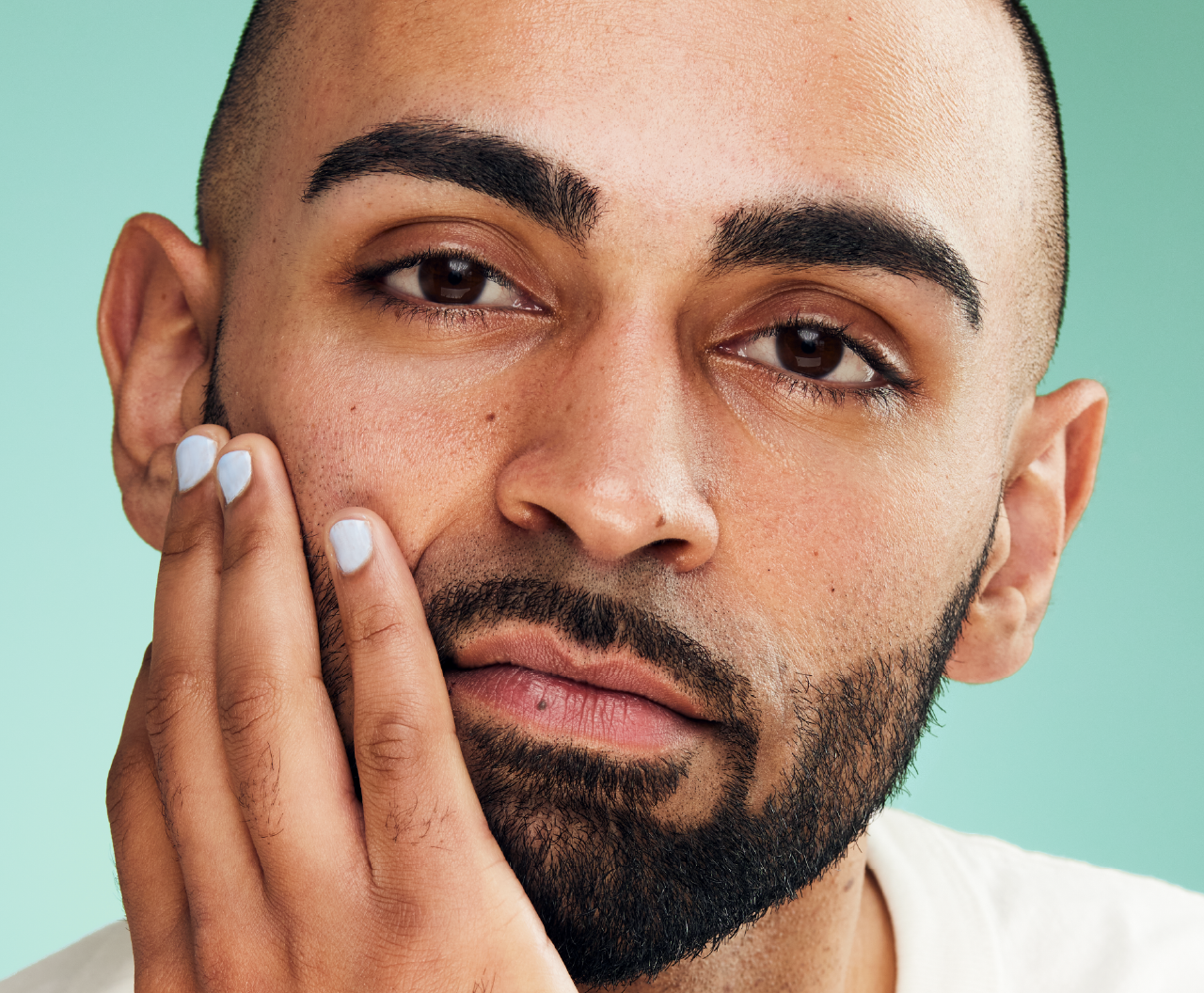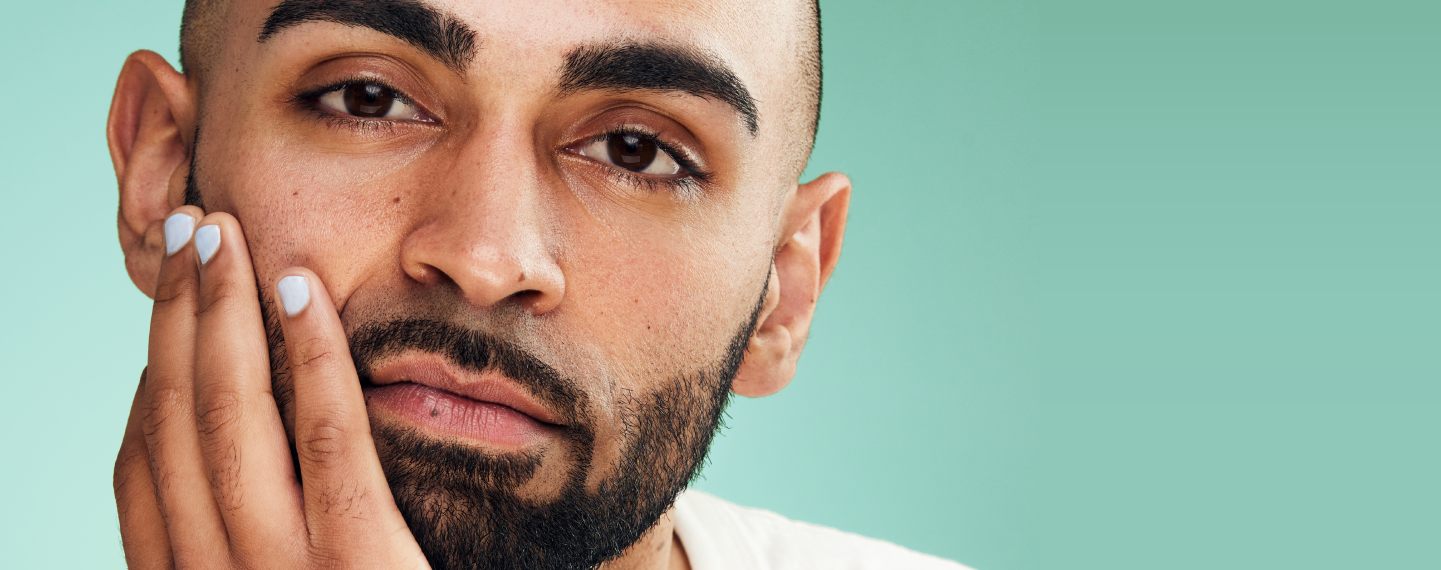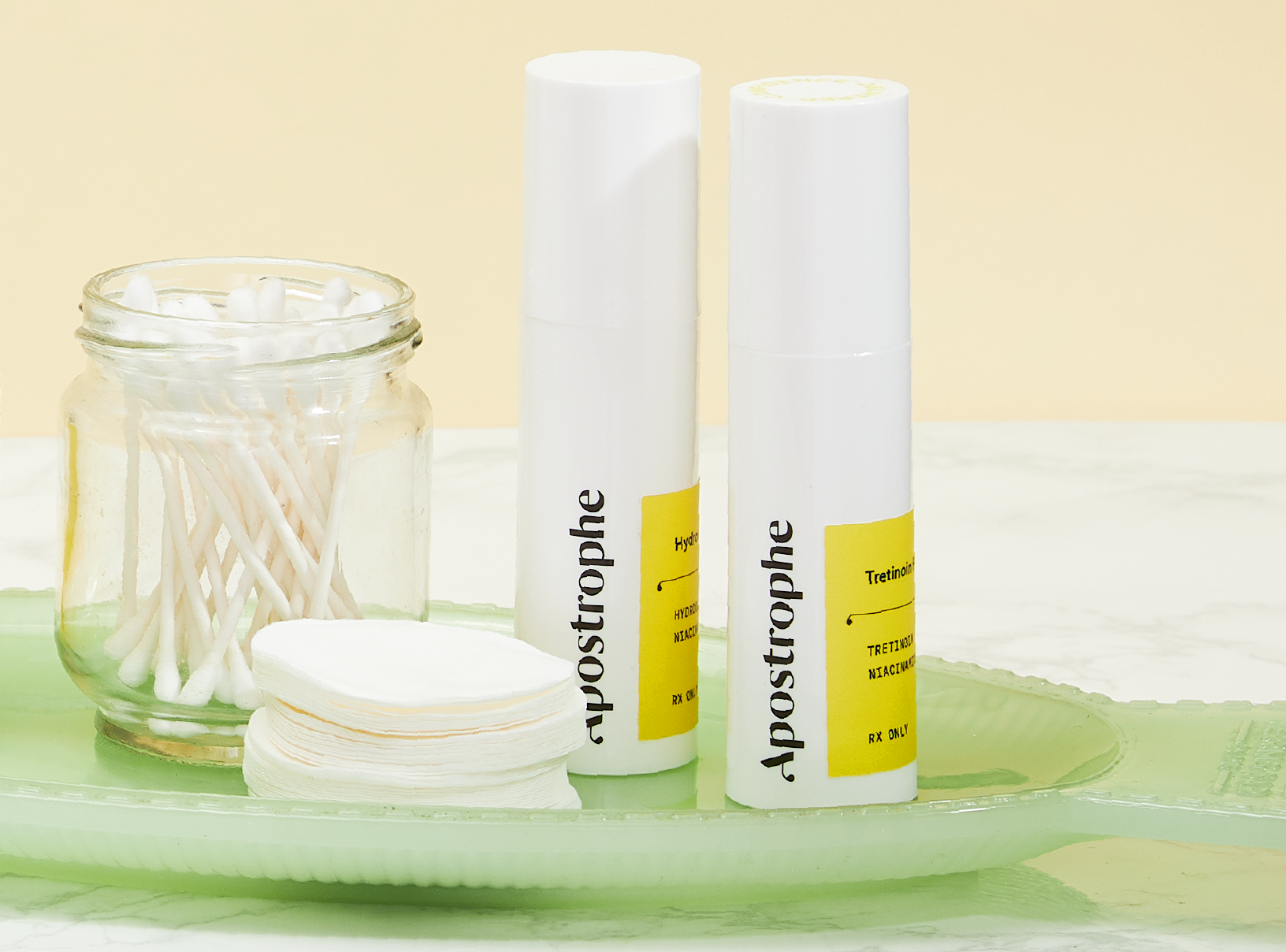Deep Dives
How to take care of your skin


SHARE
Deep Dives
How to take care of your skin
Medically reviewed by Katelyn Hagerty FNP
Written by Apostrophe Team
Last updated 11/1/2024
Your skin is your body’s largest organ, as well as its first layer of defense against bacteria, fungi, and other pathogens.
It’s also a part of your body that, more than any other, signals to the outside world certain things about your habits and general health.
While terms like “skin care” might make you think of costly products and complicated routines, the reality is that taking care of your skin is both far less complicated and much less expensive than it’s made out to be in popular media.
From protecting yourself from the sun to moisturizing, sleeping well, and staying on top of spots, moles, and acne, the right habits can keep your skin healthy and youthful in appearance as you get older, all at a relatively low cost.
Below, we’ve discussed the As to Zs of skin care for men, covering everything from suggested skin care habits to proven, science-based products that belong on your countertop. We’ve also busted a few common skin care myths in the process.
Protect Your Skin From Sun Damage
Although it’s normal to develop a few wrinkles as you get older, the right habits can reduce the effects of aging on your skin and keep you looking youthful well into your 30s, 40s, and 50s.
One of these habits is protecting your skin from the sun. Sun exposure is extremely damaging for your skin. The more your skin is exposed to direct sunlight over the course of your life, the more likely it is to display wrinkles, age spots, and other common signs of aging.
This is because the UV rays in sunlight can damage your skin at the DNA level, reducing your skin’s production of important structural proteins like elastin and collagen.
Over time, this process degrades your skin’s structure, accelerating the natural effects of aging and potentially making you look older than you really are.
According to the Skin Cancer Foundation, photoaging — the type of aging that’s associated with sun exposure — is responsible for about 90 percent of the visible changes that occur in your skin as you get older.
Now, it’s obviously impossible to totally block UV exposure from your life. However, a few simple habits can significantly cut down the amount of damage that UV radiation from the sun is able to do to your skin. Try to:
Wear sunscreen. Apply sunscreen to your skin whenever you spend time outside, even if it’s a cloudy day. The American Academy of Dermatology recommends using SPF 30+ sunscreen that’s water resistant and offers broad-spectrum protection.

HYPERPIGMENTATION TREATMENT
Target dark spots and hyperpigmentation with customized prescription treatment.
Use clothing to protect your skin. If it’s bright and sunny, make sure to wear clothing that covers your skin and protects you from direct sunlight. Wear a hat and sunglasses to protect your face and eyes.
Avoid tanning. While a tan might look nice now, the UV radiation that’s required to get one can cause serious damage to your skin over the long term. Avoid tanning, whether you do it outside or indoors using a tanning bed.
Spend time in the shade. Use natural shade to your advantage, especially during the peak sunlight hours between 10 a.m. and 2 p.m.
Be careful near snow, sand, and water. These can reflect UV radiation onto your skin, causing damage. Make sure to use sunscreen and reapply it throughout the day if you like to swim, surf, ski, or do other activities in these settings.
If You Smoke, Quit
Smoking isn’t just terrible for your heart and lungs — it’s also damaging to the structural proteins that make up your skin.
Research shows that cigarette smoking may speed up the effects of aging on your skin, making you look older than you really are.
For example, a study published in the International Journal of Dermatology found that smokers tend to show a higher degree of facial wrinkling and rougher skin texture than non-smokers and past smokers of the same age.
If you smoke, quitting may help to improve your skin health and slow down the development of wrinkles and other common age-related skin issues.
Check Your Skin for Moles & Other Growths
Not only does sun exposure age your skin prematurely — it can also significantly increase your risk of developing skin cancer.
Even if you’re careful not to spend too much time in the sun, it’s important to check your skin for common signs of skin cancer every few months, especially if you live in a region that gets lots of sunlight.
You can do this by checking your skin by yourself in the mirror or checking with a partner. Make an appointment with a dermatologist if you notice any spots that are:
Different from others
Changing in appearance
Itchy and/or bleeding
The American Academy of Dermatology has a helpful skin cancer infographic that you can use to examine your skin at home and identify signs of skin cancer.
Learn Your Skin Type
From oily to sensitive, everyone’s skin is slightly different. By understanding the type of skin you have, you can choose skin care products that are designed specifically for your needs.
Most skin care experts recognize five different skin types:
Dry skin, which is flaky, rough in texture and/or itchy
Oily skin, which is oily and has a shiny appearance
Sensitive skin, which stings or burns easily from some products
Combination skin, which is both dry and oily in different areas
Normal skin, which has a typical texture and isn’t overly sensitive
Once you’ve identified your skin type, look for products that are designed for your needs. Many products are formulated specifically for common skin types using ingredients that are less likely to cause dryness, oiliness, irritation, or other common issues.
Clean Your Skin The Right Way
Washing your face regularly helps to remove dead skin cells, clean away excess sebum, and get rid of bacteria and other germs that can worsen common skin issues like acne.
While washing your face might seem easy, it’s important to follow the right process to keep your skin clean without causing any damage or irritation.
It’s best to wash your face a maximum of two times a day, as well as after you exercise or take part in other activities that make you sweat. When you wash your face more than twice a day, you may increase your risk of developing dryness and irritation.
When you wash your face, use a gentle cleanser that doesn’t contain any alcohol. Make sure to apply your cleanser carefully using your fingertips. Avoid scrubbing your skin with a washcloth or other device, as this may cause irritation.
Once you’ve finished washing your face, gently pat your skin dry using a clean, soft towel. For best results, apply a moisturizer after you finish washing your face by following the instructions provided below.
Moisturize Every Day
Using a moisturizer is one of the simplest, most effective things that you can do to keep your skin healthy, hydrated, and in optimal condition.
Moisturizer traps water in your skin, giving it a more youthful appearance and making fine lines, wrinkles, and other common signs of aging less visible. It also helps to prevent your skin from becoming dried out and irritated.
Using a moisturizer is simple. To keep your skin optimally hydrated, try to apply moisturizer after you finish showering or shaving, preferably while your skin is still slightly damp. Make sure to reapply moisturizer whenever your skin feels dry.
Understand How Acne Develops
Acne is one of the most common skin concerns, especially for people in their teens and early 20s.
Like with many other skin-related topics, there are countless myths about how acne develops and what causes it to worsen.
Contrary to popular belief, acne breakouts aren’t caused by dirt, greasy foods or not spending enough time in the sun.
The reality of acne is that it’s caused by three things. The first of these is a type of natural oil that’s produced by your skin called sebum. The second is the accumulation of dead skin cells on the surface of your skin over time.
These two things can combine inside your pores, causing them to become clogged and form into acne lesions.
The third factor in acne is bacteria. Over time, bacteria can multiply inside clogged pores and cause your acne to become more inflamed, red, and painful.
Once you understand what causes acne, choosing science-backed, proven products to prevent acne breakouts becomes far easier. We’ve shared several recommendations for treating acne below.
Use Retinoids to Prevent Acne and Aging
Retinoids are a class of medications that are derived from vitamin A. They work by increasing the speed at which your skin replaces old, dead cells with new ones through a process called epidermal turnover.
Many retinoids, particularly one called tretinoin, have been used for decades as treatments for both acne breakouts and common signs of aging such as wrinkles and age spots.

PRESCRIPTION TRETINOIN
Target acne, dark spots, and signs of aging with this science-backed ingredient.
A significant amount of research shows that retinoids are effective at treating acne and slowing down the effects of aging on your skin.
For example, a detailed review published in Dermatology and Therapy, which used data from a large selection of different studies, concluded that retinoids are “highly efficacious” for inflamed and noninflamed acne breakouts.
Another scientific review published in Clinical Interventions in Aging described retinoids as the most promising agents available for treating the effects of aging.
Since retinoids are decades old, they’re available as inexpensive generic medications, making them a great low-cost, high-results addition to your skin care routine.
You can find mild retinoids such as retinol and adapalene in over-the-counter creams and other products available in most drugstores.
Tretinoin, a particularly effective retinoid, is one of several ingredients that might be in your Apostrophe topical treatment.
You can learn more about how retinoids work for acne prevention and anti-aging in our detailed guide to tretinoin.
If Needed, Add Other Acne Treatments
In addition to topical retinoids, other medications can help to treat and prevent acne breakouts by lowering sebum levels, getting rid of dead skin cells, and stopping the growth of bacteria.
If you’re prone to acne, it’s best to talk to a healthcare provider. They may recommend one or several of the following medications:
Benzoyl peroxide. This topical medication works by preventing the growth of bacteria that can worsen acne. It’s available as a cream, gel, or as an active ingredient in many over-the-counter facial cleansers for treating acne.
Salicylic acid. Salicylic acid works by unclogging blocked pores and reducing redness and swelling caused by acne. Like benzoyl peroxide, you can find it as an ingredient in many over-the-counter cleansers and facial washes.
Clindamycin. An antibiotic, clindamycin works by decreasing swelling and stopping the growth of bacteria that can cause painful, infected acne.
Make sure to also look for skin care products labeled “non-comedogenic” or “oil free.” These are formulated to reduce your risk of developing clogged pores, making them a good option if you’re prone to acne breakouts.
Be Careful When You Shave
The way you shave can have a surprisingly large impact on your skin. Not only can shaving lead to cuts and scratches, but shaving too aggressively or on skin that’s too dry can also cause painful razor burns.
Before you shave, wet your hair so that it’s moist and soft. Make sure to use shaving cream with a moisturizing formula, especially if you often get dry skin after shaving.
To minimize your risk of getting razor burn or ingrown hairs, use a single or double-bladed razor and shave in the direction that your hair grows. Make sure to rinse your razor regularly to get rid of hair buildup that can increase friction and irritate your skin.
In Conclusion
Taking good care of your skin doesn’t need to mean committing to a complicated, costly routine that involves one product after the other.
In fact, a few simple changes to your habits, such as using sunscreen, applying moisturizer and occasionally using medications such as tretinoin, can have a noticeable impact on the way your skin looks and feels as you get older.
If you’re interested in taking care of your skin and preventing issues such as acne and wrinkles, consider talking to a licensed healthcare provider to learn more about your options.
References:
Grabel, A. (2019, January 10). Photoaging: What You Need to Know About the Other Kind of Aging. Retrieved from https://www.skincancer.org/blog/photoaging-what-you-need-to-know/
Sunscreen FAQs. (n.d.). Retrieved from https://www.aad.org/public/everyday-care/sun-protection/sunscreen-patients/sunscreen-faqs
Koh, J.S., Kang, H., Choi, S.W. & Kim, H.O. (2002, January). Cigarette smoking associated with premature facial wrinkling: image analysis of facial skin replicas. International Journal of Dermatology. 41 (1), 21-7. Retrieved from https://pubmed.ncbi.nlm.nih.gov/11895509/
How Can I Tell if I Have Skin Cancer? (n.d.). Retrieved from https://www.aad.org/public/diseases/skin-cancer/find/know-how
Infographic: Skin Cancer Body Mole Map. (n.d.). Retrieved from https://www.aad.org/public/diseases/skin-cancer/find/at-risk/mole-map
Skin Care Tips for Men. (n.d.). Retrieved from https://www.aad.org/public/everyday-care/skin-care-basics/care/skin-care-for-men
Face Washing 101. (n.d.). Retrieved from https://www.aad.org/public/everyday-care/skin-care-basics/care/face-washing-101
10 Skin Care Habits That Can Worsen Acne. (n.d.). Retrieved from https://www.aad.org/public/diseases/acne/skin-care/habits-stop
Moisturizer: Why You May Need it if You Have Acne. (n.d.). Retrieved from https://www.aad.org/public/diseases/acne/skin-care/moisturizer
Common Myths About Acne. (n.d.). Retrieved from https://www.wakehealth.edu/Stories/Common-Myths-About-Acne
Acne. (n.d.). Retrieved from https://www.americanskin.org/resource/acne.php
Elias, P.M. (1986, October). Epidermal effects of retinoids: supramolecular observations and clinical implications. Journal of the American Academy of Dermatology. 15 (4 Pt. 2), 797-809. Retrieved from https://pubmed.ncbi.nlm.nih.gov/2430000/
Leyden, J., Stein-Gold, L. & Weiss, J. (2017, September). Why Topical Retinoids Are Mainstay of Therapy for Acne. Dermatology and Therapy. 7 (3), 293–304. Retrieved from https://www.ncbi.nlm.nih.gov/pmc/articles/PMC5574737/
Mukherjee, S., et al. (2006, December). Retinoids in the treatment of skin aging: an overview of clinical efficacy and safety. Clinical Interventions in Aging. 1 (4), 327–348. Retrieved from https://www.ncbi.nlm.nih.gov/pmc/articles/PMC2699641/
Matin, T. & Goodman, M.B. (2020, November 24). Benzoyl Peroxide. StatPearls. Retrieved from https://www.ncbi.nlm.nih.gov/books/NBK537220/
Salicylic Acid Topical. (2016, September 15). Retrieved from https://medlineplus.gov/druginfo/meds/a607072.html
Clindamycin Topical. (2016, October 15). Retrieved from https://medlineplus.gov/druginfo/meds/a609005.html
Shop this post

Tretinoin
Like what you just read? Sign up for our email list to get the scoop on skincare science delivered straight to your inbox.

Deep Dives
A dermatologist shares his thoughts on the recent studies about benzoyl peroxide and benzene.
Read More
Education
What is milia?
What is milia? Today, we’re jumping into one type of bump that you may have heard about most commonly in infants — milia.
Read More
Education
Best moisturizer for acne-prone skin
If you have combination acne-prone skin, figuring out which moisturizer is best for your skin might be tough. In this guide, we break down the best moisturizer for combination, acne-prone skin.
Read More